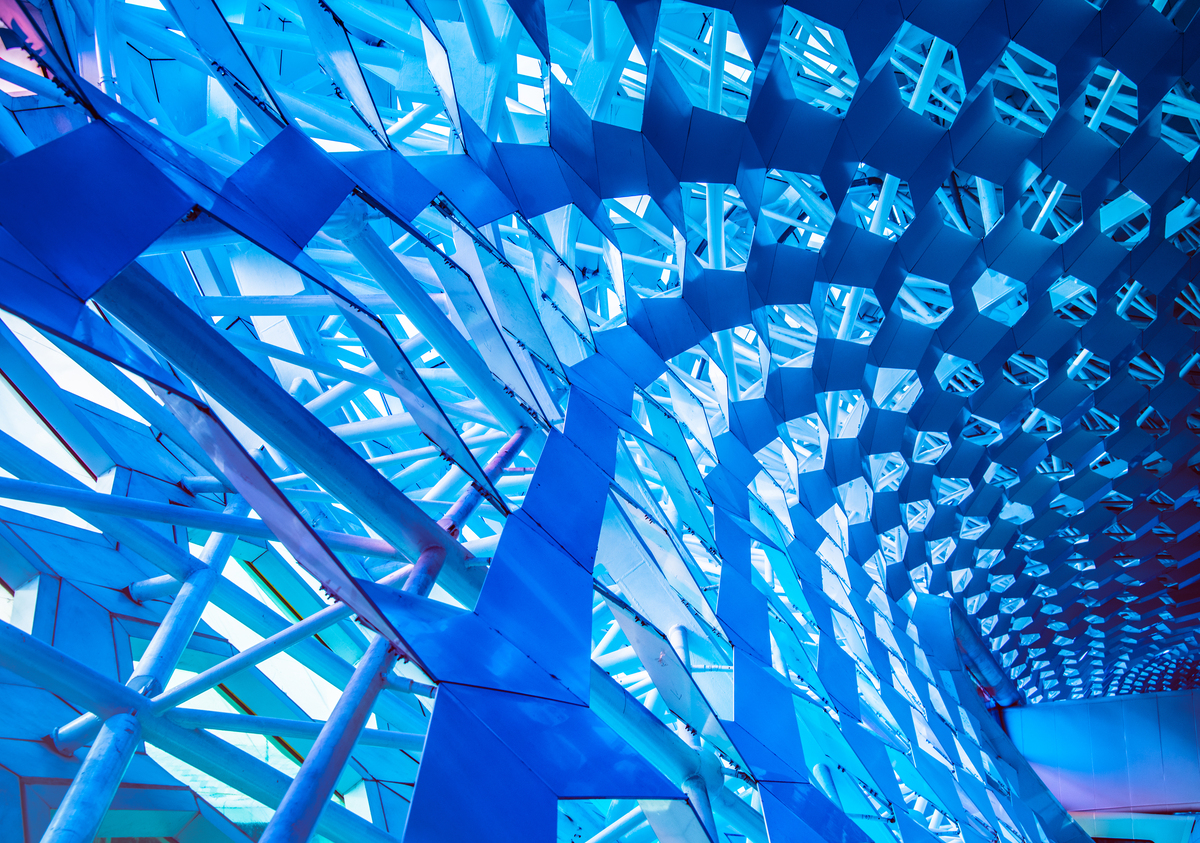Updated by Nazanin Ghodsian, 08/12/2024
Integrating biotechnology in architecture has transformed the construction industry by developing sustainable, innovative approaches to pressing environmental challenges. Buildings account for 40% of the world’s energy consumption and produce a large amount of trash, so there is an increasing need for environmentally friendly architecture.
Biotechnology in architecture creates adaptable materials, living structures, and energy-efficient systems by using living organisms and biomimicry. This method paves the path for a resilient and sustainable future by improving the functional and aesthetic qualities of architecture while also lessening its negative effects on the environment.
This investigation explores how biotechnology is changing architecture through a variety of applications, case studies, and new trends. Biotechnology provides architects with an extensive arsenal for designing ecologically conscious and visually striking structures, ranging from green building materials like bioplastics and mycelium-based goods to creative living walls and bioluminescent lights. Architects can create buildings that self-heal, adapt to their surroundings, and promote a healthier atmosphere by utilizing biological processes.
The importance of biotechnology in architecture is growing as our environmental problems get more severe. This thorough analysis emphasizes how crucial it is to incorporate these technologies into architectural practice, providing useful insights and stimulating creativity for a more eco-friendly built environment in the future.
Suggested article to read: Case Study: Top 4 Eco-Friendly Smart Building Construction Projects
Table of Contents
Top Ways that Biotechnology in Architecture Will be Used
In the ever-evolving landscape of architecture, biotechnology emerges as a transformative force, poised to revolutionize the way we design, construct, and inhabit buildings. Here, we delve into the top ways biotechnology will shape the future of architecture:
1. Sustainable Materials
In recent years, biotechnology in architecture has emerged as a promising avenue for revolutionizing the materials used in the industry, particularly in the quest for sustainability. This paradigm shift towards biologically derived materials offers architects and designers the opportunity to create structures that are not only aesthetically pleasing but also environmentally responsible and resilient. Here, we delve into the use of biotechnology in architecture through the lens of sustainable materials.
1. Biologically Derived Materials: Biotechnology in architecture facilitates the development and utilization of materials derived from living organisms or biological processes. Examples include bio-bricks made from bacteria that bind together sand or mycelium-based composites grown from fungi. These materials not only reduce reliance on traditional, energy-intensive construction materials like concrete and steel but also have the potential to sequester carbon dioxide during their growth process.
2. Environmental Benefits: The use of biologically derived materials in architecture offers significant environmental benefits. These materials are often renewable, biodegradable, and have a lower carbon footprint compared to conventional alternatives. For instance, bioplastics made from plant-based sources such as corn or sugarcane can replace petroleum-based plastics, reducing reliance on fossil fuels and mitigating plastic pollution.
3. Increased Durability and Performance: Contrary to the misconception that sustainable materials may compromise on durability, biotechnologically derived materials often exhibit impressive performance characteristics. For example, bio-bricks have shown excellent compressive strength comparable to traditional masonry materials, while mycelium-based composites possess inherent fire resistance and insulation properties. Moreover, these materials can be engineered to be self-repairing, further enhancing their longevity.

4. Customization and Adaptability: Biotechnology in architecture enables the customization and adaptation of materials to suit specific architectural needs. Through genetic engineering and biomimetic design principles, materials can be tailored for enhanced properties such as strength, flexibility, and color. This level of customization allows architects to innovate and push the boundaries of traditional building materials, opening up new possibilities for creative expression and functional design.
5. Promoting Circular Economy in Construction: By utilizing biologically derived materials, architects contribute to the promotion of a circular economy within the construction industry. These materials can be sourced sustainably, recycled, or returned to the natural environment at the end of their lifecycle, minimizing waste and resource depletion. Additionally, the biodegradability of these materials reduces the environmental impact associated with construction and demolition activities.
The integration of biotechnology in architecture through the use of sustainable materials represents a significant step towards creating more ecologically responsible and resilient built environments. By harnessing the power of nature, architects can design structures that not only minimize environmental harm but also contribute positively to the health and well-being of both inhabitants and the planet. As biotechnological advancements continue to evolve, the potential for innovation in sustainable architecture is boundless, paving the way for a more sustainable and harmonious relationship between humans and their built environment.
Suggested article to read: Resilient Construction; 2024 Guide | Sustainable Construction; Comprehensive Guide 2024
2. Adaptive Facades
Adaptive facades, also known as dynamic or responsive facades, represent a significant advancement in architectural design, offering buildings the ability to respond intelligently to environmental conditions. Biotechnology in architecture has played a pivotal role in the development of these innovative building envelopes, transforming traditional static facades into dynamic systems capable of adapting to varying external stimuli. Here, we explore the use of biotechnology in adaptive facades and its implications for sustainable architecture.
1. Biologically Inspired Design: Biotechnology in architecture draws inspiration from nature’s adaptive mechanisms, leading architects and engineers to develop facade systems that mimic biological processes. By studying natural systems such as the human skin or plant structures, designers can emulate the ability of living organisms to regulate temperature, moisture, and light levels in response to external factors.
2. Responsive Materials and Systems: Biotechnological advancements have led to the creation of responsive materials that can change properties in real-time. For example, smart materials embedded with microorganisms or responsive polymers can alter their transparency, thermal conductivity, or insulation properties in response to environmental cues such as sunlight intensity or temperature fluctuations. These materials form the basis of adaptive facade systems capable of dynamically adjusting to changing conditions.
3. Energy Efficiency in Buildings and Comfort: Adaptive facades enhance energy efficiency and occupant comfort by optimizing building performance in real-time. By modulating daylight penetration, solar heat gain, and natural ventilation, these facades reduce the reliance on mechanical heating, cooling, and lighting systems, thereby lowering energy consumption and operational costs. Additionally, occupants benefit from improved thermal comfort and access to natural light, promoting well-being and productivity.
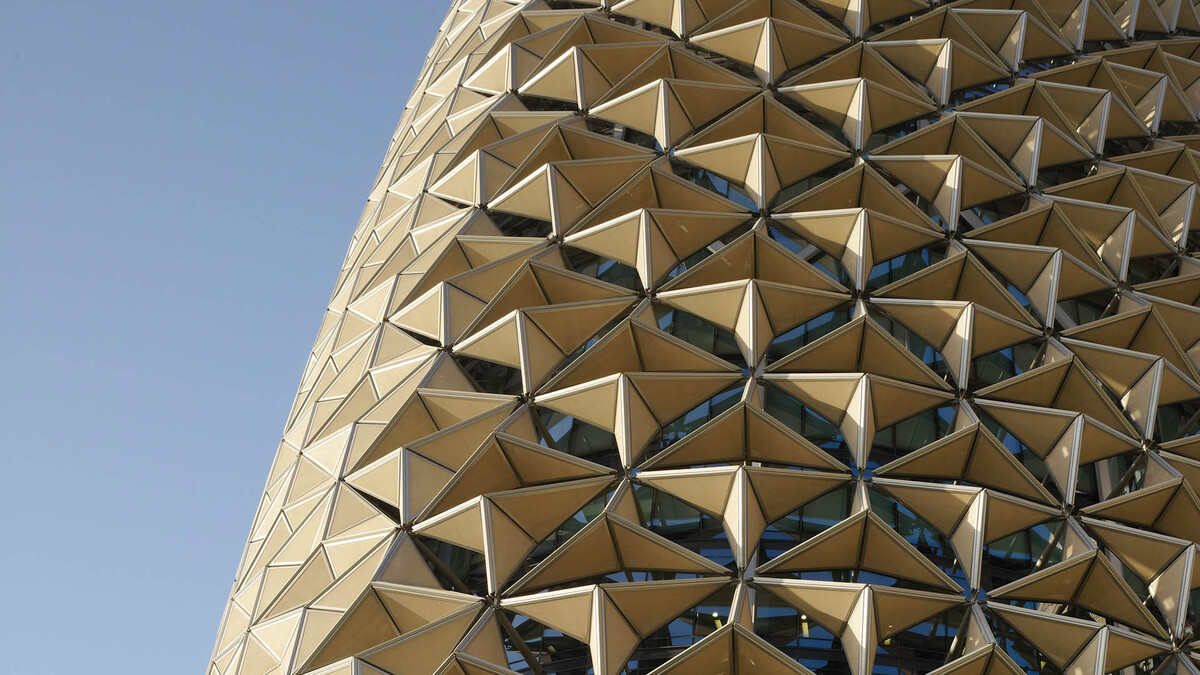
4. Integration of Sensors and Control Systems: Biotechnology in architecture facilitates the integration of sensors and control systems into adaptive facade designs, enabling precise monitoring and regulation of environmental parameters. Sensors embedded within the facade can detect changes in temperature, humidity, air quality, and daylight levels, while control algorithms adjust the facade’s configuration accordingly. This seamless interaction between sensors, actuators, and building management systems ensures optimal performance and adaptability.
5. Sustainable Building Practices: The incorporation of biotechnology in adaptive facades aligns with principles of sustainable architecture by reducing energy consumption, minimizing environmental impact, and enhancing building resilience. By harnessing natural processes and materials, these facades contribute to the creation of more ecologically responsible built environments, mitigating the effects of climate change and promoting resource efficiency.
Biotechnology in architecture has revolutionized the design and functionality of adaptive facades, offering architects and designers unprecedented opportunities to create buildings that are responsive, efficient, and environmentally sustainable. As technology continues to advance, the integration of biologically inspired systems and materials into architectural practice holds immense promise for the future of sustainable design, ushering in an era of dynamic and adaptive built environments that harmonize with the natural world.
Suggested article to read: Top 24 Sustainable Construction Technologies in 2024
3. Living Architecture
Living architecture represents a paradigm shift in the field of building design, where structures integrate living organisms as integral components. Biotechnology in architecture has played a crucial role in the development of living architecture, enabling the creation of buildings that not only provide shelter but also actively contribute to ecological balance and human well-being. Here, we explore the multifaceted applications of biotechnology in living architecture and its implications for sustainable urban development.
1. Integration of Living Organisms: Biotechnology in architecture allows architects to incorporate various living organisms, such as algae, moss, plants, and microorganisms, into building systems. These organisms can be integrated into facade panels, roof gardens, interior walls, and other architectural elements, creating dynamic and biologically active environments. For example, algae-filled bioreactors can be integrated into building facades to capture carbon dioxide and generate renewable energy through photosynthesis.
2. Environmental Sustainability: Living architecture promotes environmental sustainability by enhancing ecosystem services within the built environment. Living organisms play vital roles in air purification, carbon sequestration, water filtration, and biodiversity conservation. By harnessing the natural processes of these organisms, living buildings can mitigate air and water pollution, reduce urban heat island effects, and support local ecosystems, contributing to overall urban resilience and sustainability.
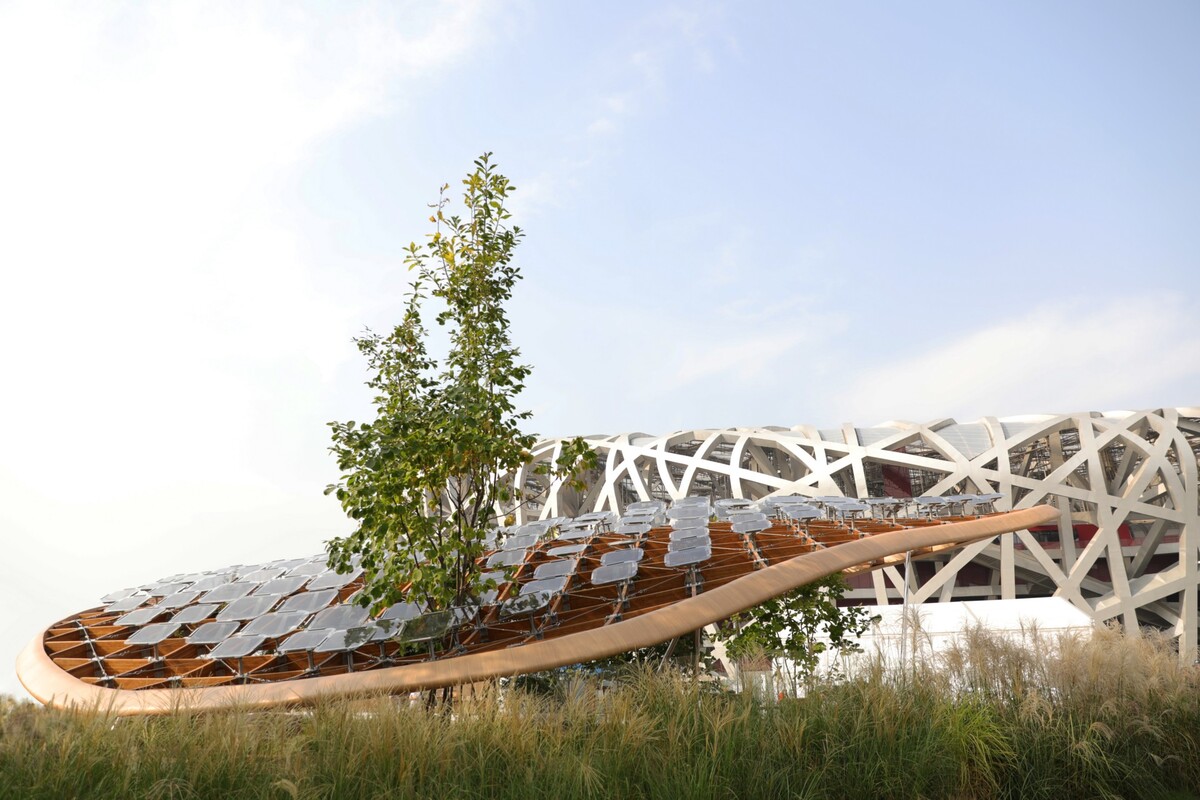
3. Biophilic Design Principles: Biotechnology in architecture enables architects to embrace biophilic design principles, which emphasize the innate human connection with nature. Living architecture incorporates natural elements, patterns, and materials into building designs, fostering a sense of connection and well-being among occupants. Biophilic features such as green walls, rooftop gardens, and indoor plantings not only enhance aesthetic appeal but also promote psychological well-being, reduce stress, and increase productivity.
4. Adaptive and Responsive Environments: Living architecture creates adaptive and responsive environments that interact dynamically with changing environmental conditions. Living organisms, such as responsive plants and algae, can adjust their growth patterns, coloration, and metabolic activity in response to variations in light, temperature, humidity, and air quality. This adaptive capacity enables buildings to regulate internal climates, optimize energy use, and create comfortable and healthy indoor environments for occupants.
5. Urban Biodiversity and Connectivity: Biotechnology in architecture facilitates the creation of living architecture that enhances urban biodiversity and connectivity. Green roofs, vertical gardens, and urban wetlands integrated into buildings provide habitats and corridors for diverse plant and animal species, promoting ecological resilience and species survival in densely populated urban areas. These green spaces also offer opportunities for education, recreation, and community engagement, fostering a deeper appreciation for nature in urban settings.
The integration of biotechnology in living architecture represents a transformative approach to building design that prioritizes ecological sustainability, human well-being, and urban resilience. By harnessing the power of living organisms, architects can create buildings that actively contribute to environmental health, foster biophilic connections, and adapt to changing environmental conditions. As biotechnological advancements continue to evolve, the potential for innovation in living architecture is vast, offering promising solutions to the complex challenges of urbanization and climate change.
Suggested article to read: Sustainable Construction Technology; Ultimate Guide in 2024
4. Biophilic Design
Biophilic design is a concept rooted in the innate human affinity for nature, aiming to integrate natural elements and processes into the built environment to enhance well-being, productivity, and sustainability. Biotechnology plays a crucial role in advancing biophilic design principles, offering architects innovative solutions to create spaces that reconnect occupants with the natural world. Here, we explore the diverse applications of biotechnology in biophilic design and its transformative impact on architectural practice.
1. Bio-Inspired Materials and Textures: Biotechnology in architecture enables the development of materials and textures that mimic natural patterns, textures, and colors found in the environment. Through biomimetic design approaches, architects can create surfaces, finishes, and structural elements that evoke the sensory experiences of nature, such as wood grain textures, leaf-inspired patterns, or stone-like surfaces. These bio-inspired materials not only enhance aesthetic appeal but also evoke feelings of comfort, tranquility, and connection with the natural world.
2. Living Walls and Vertical Gardens: Biotechnology in architecture facilitates the creation of living walls and vertical gardens, which integrate vegetation into building facades and interior spaces. Living walls utilize hydroponic or soil-based systems to support diverse plant species, enhancing air quality, humidity regulation, and thermal comfort within buildings. Biotechnological innovations, such as automated irrigation systems and modular planting systems, enable the maintenance and management of living walls in indoor and outdoor environments, contributing to biophilic experiences for occupants.
3. Bioluminescent Lighting: Biotechnology in architecture offers novel lighting solutions inspired by bioluminescent organisms found in nature. Bioluminescent lighting systems utilize genetically engineered microorganisms or synthetic materials to emit natural, soft light reminiscent of moonlight or fireflies. These bioluminescent fixtures create captivating visual experiences, promote circadian rhythms, and reduce reliance on artificial lighting, fostering a deeper connection with the diurnal rhythms of the natural world.
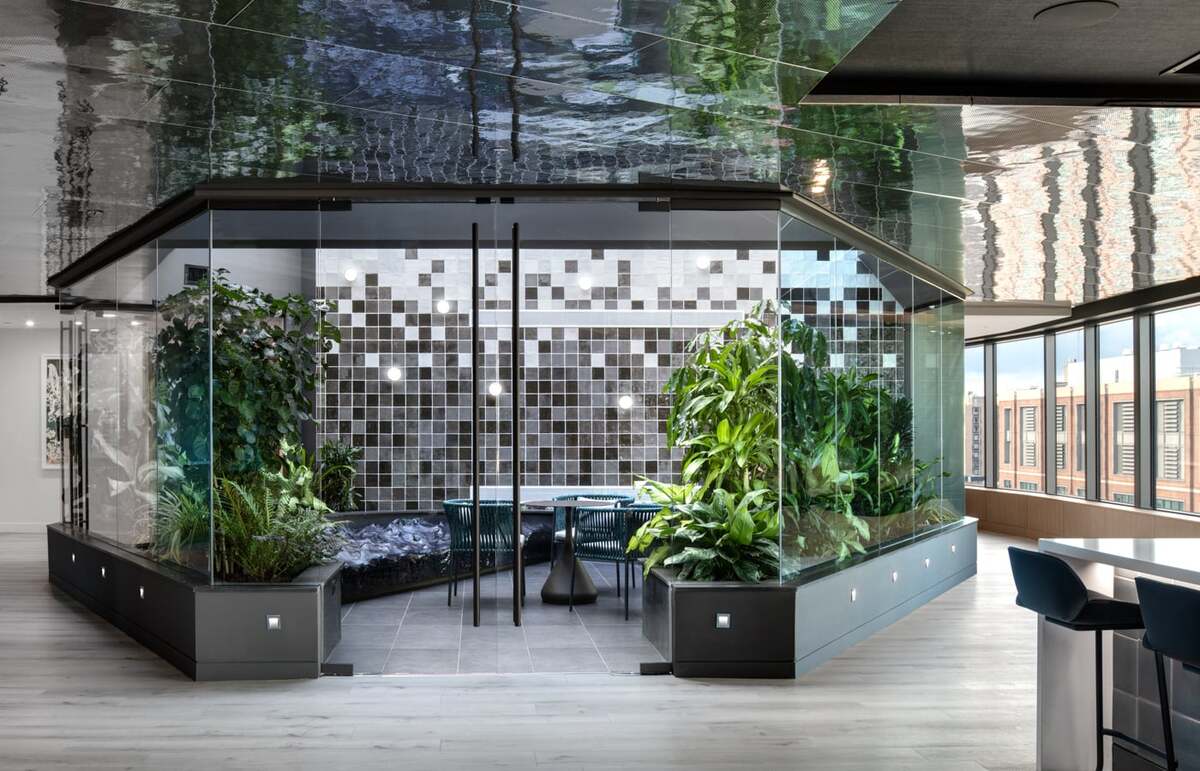
4. Phytochemical Air Purification: Biotechnology enables the use of phytochemical processes for air purification within indoor environments. Certain plant species possess natural abilities to absorb and metabolize airborne pollutants, such as volatile organic compounds (VOCs) and formaldehyde. By incorporating these air-purifying plants into interior spaces, architects can improve indoor air quality, reduce respiratory ailments, and create healthier and more productive environments for occupants.
5. Biophilic Data Visualization: Biotechnology facilitates the visualization of biological data and patterns to inform design decisions and create interactive biophilic experiences. Through bioinformatics, architects can analyze ecological data, such as biodiversity hotspots, seasonal migration patterns, or natural ecosystems, and translate this information into visualizations, artworks, or interactive installations embedded within architectural spaces. These biophilic data visualizations engage occupants with the natural world, fostering environmental awareness, and ecological literacy.
Biotechnology offers architects a rich palette of tools and techniques to integrate biophilic design principles into the built environment, creating spaces that nourish the mind, body, and spirit. By harnessing the transformative potential of biotechnology, architects can design buildings that blur the boundaries between indoors and outdoors, evoke sensory experiences of nature, and promote holistic well-being for occupants. As biotechnological advancements continue to evolve, the possibilities for innovation in biophilic design are limitless, offering promising solutions to the challenges of urbanization, climate change, and human health.
Suggested article to read: Sustainable Development Goals in Construction Industry; Guide 2024
5. Self-Healing Structures
Self-healing structures represent a groundbreaking approach to architectural design, where buildings possess the ability to repair damage autonomously, akin to the regenerative capabilities found in living organisms. Biotechnology in architecture plays a pivotal role in the development of self-healing materials and systems, offering architects innovative solutions to enhance the durability, resilience, and sustainability of built environments. Here, we explore the diverse applications of biotechnology in self-healing structures and its transformative impact on architectural practice.
1. Bio-Inspired Materials: Biotechnology enables the development of self-healing materials inspired by biological systems found in nature. For example, researchers have explored the use of bacteria, fungi, and other microorganisms to create bio-cementitious materials capable of autonomously repairing cracks and fractures in concrete structures. These bio-inspired materials mimic the wound-healing mechanisms observed in living organisms, enabling buildings to maintain structural integrity and prolong their lifespan.
2. Microbial Mediated Repair: Biotechnology in architecture leverages microbial mediated processes to facilitate the repair of damaged building materials. Certain bacteria and fungi possess the ability to precipitate minerals, such as calcium carbonate or silica, in response to environmental stimuli, forming self-healing bio-mineralization agents. By embedding these microorganisms within concrete or other construction materials, architects can create self-repairing structures that heal cracks and gaps over time, reducing the need for costly repairs and maintenance.
3. Genetic Engineering: Biotechnology enables the genetic engineering of microorganisms to enhance their self-healing capabilities and compatibility with building materials. Researchers can manipulate the genetic makeup of bacteria and fungi to optimize their performance in specific environmental conditions, such as high humidity, low pH, or extreme temperatures. By engineering microorganisms to produce specific enzymes or proteins involved in biomineralization processes, architects can tailor self-healing systems to suit the unique requirements of different construction projects.
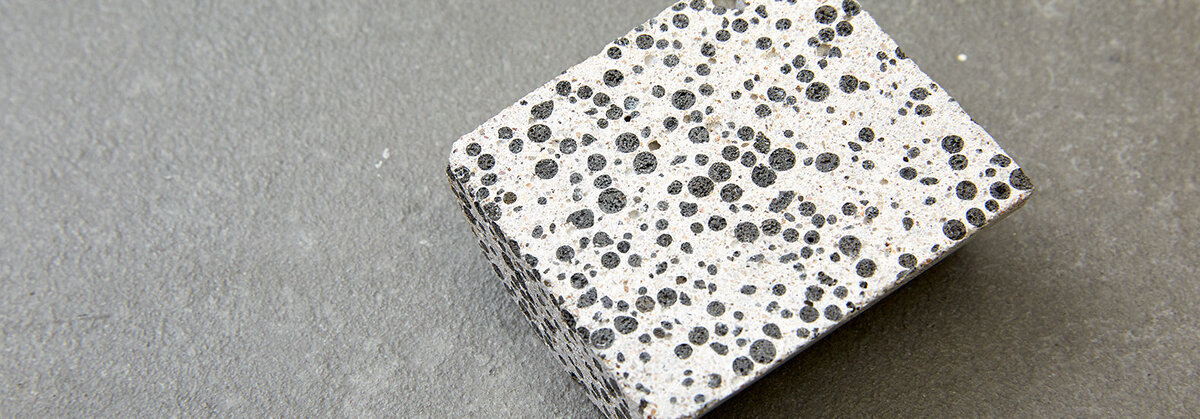
4. Autonomous Repair Systems: Biotechnology in architecture facilitates the development of autonomous repair systems embedded within building structures. For example, researchers have explored the use of vascular networks filled with healing agents, such as epoxies or polymers, to deliver repair materials to damaged areas within concrete or composite materials. These self-contained repair systems detect and respond to structural damage, triggering the release of healing agents to seal cracks and reinforce weakened areas, ensuring structural integrity and safety.
5. Environmental Sustainability: Self-healing structures contribute to environmental sustainability by reducing the need for resource-intensive repair and maintenance activities. By minimizing material waste, energy consumption, and carbon emissions associated with conventional repair methods, self-healing technologies promote resource efficiency and lifecycle sustainability in the construction industry. Additionally, the prolonged lifespan of self-healing structures reduces the demand for new construction materials, further mitigating environmental impact and promoting circular economy principles.
Biotechnology offers architects a revolutionary approach to creating self-healing structures that possess the resilience and adaptability of living organisms. By harnessing the regenerative potential of biological systems, architects can design buildings that are capable of repairing and adapting to environmental stresses over time, ensuring longevity, safety, and sustainability. As biotechnological advancements continue to progress, the integration of self-healing technologies into architectural practice holds immense promise for shaping the future of resilient and eco-friendly built environments.
Suggested article to read: Discovering the World’s Top 29 Sustainable Buildings | What is Sustainable Construction Project Management? 2024 Guide
6. Biomimicry in Construction
Biomimicry in construction is a design approach that draws inspiration from nature’s solutions to complex challenges, seeking to emulate biological systems and processes in building design and construction. Biotechnology in architecture plays a crucial role in advancing biomimetic strategies, enabling architects and engineers to create innovative and sustainable building solutions that are inspired by nature. Here, we explore the diverse applications of biotechnology in biomimicry and its transformative impact on construction practices.
1. Bio-Inspired Materials: Biotechnology enables the development of bio-inspired materials that replicate the structural, mechanical, and functional properties of natural materials found in living organisms. For example, researchers have explored the use of biologically derived materials, such as cellulose nanocrystals or chitin-based polymers, to create lightweight and high-strength composites for structural applications. These bio-inspired materials offer advantages such as sustainability, biodegradability, and renewable sourcing, making them ideal alternatives to traditional construction materials.
2. Self-Assembly and Self-Organization: Biotechnology facilitates the study and replication of self-assembly and self-organization processes observed in biological systems. By understanding the principles governing molecular self-assembly in living organisms, researchers can design materials and structures that autonomously organize and assemble into complex forms and configurations. For example, self-assembling nanomaterials can be used to create adaptive facades or modular building components that respond dynamically to environmental stimuli, optimizing performance and efficiency.
3. Structural Optimization and Efficiency: Biotechnology in architecture enables architects and engineers to optimize building structures and systems based on biological principles of efficiency, resilience, and adaptability. By studying the structural morphology of natural organisms, such as bones, shells, or plant tissues, researchers can design load-bearing structures that maximize strength-to-weight ratios and minimize material usage. Biomimetic design approaches, such as tensegrity structures or hierarchical geometries, offer innovative solutions for creating lightweight and efficient building systems that minimize resource consumption and environmental impact.
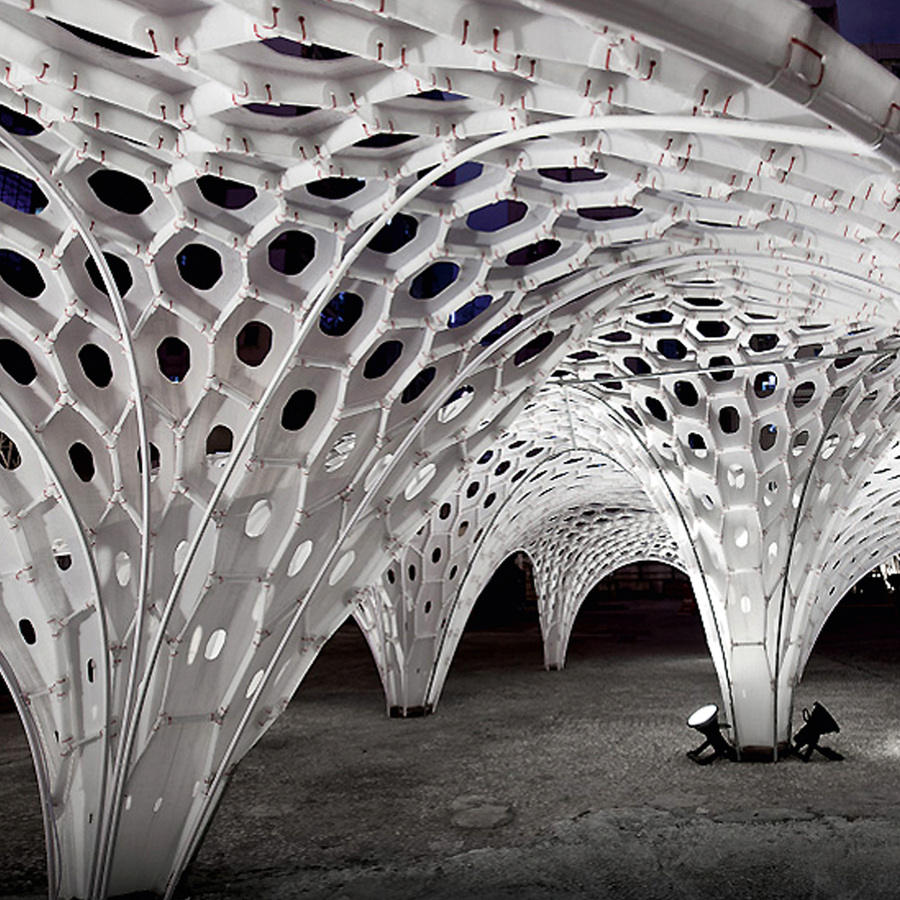
4. Environmental Sensing and Adaptation: Biotechnology facilitates the integration of environmental sensing and adaptation mechanisms into building designs, inspired by the sensory capabilities and adaptive responses of living organisms. For example, researchers have explored the use of biologically inspired sensors, such as synthetic receptors or genetically engineered cells, to detect and respond to changes in environmental conditions, such as temperature, humidity, or air quality. These biomimetic sensing systems enable buildings to optimize energy use, improve indoor comfort, and enhance occupant well-being in response to external stimuli.
5. Ecological Integration and Habitat Enhancement: Biotechnology enables architects to design buildings that seamlessly integrate with natural ecosystems and enhance biodiversity in urban environments. Biomimetic design strategies, such as green roofs, living walls, or artificial habitats, create opportunities for wildlife habitat creation, ecological restoration, and urban greening initiatives. By mimicking natural ecosystems and providing habitat for plants and animals, biomimetic buildings contribute to ecosystem services, such as pollination, pest control, and air purification, enhancing overall environmental sustainability and resilience.
Biotechnology offers architects and engineers a powerful toolkit for incorporating biomimetic principles into construction practices, creating buildings that are not only efficient, resilient, and adaptive but also ecologically harmonious and sustainable. By harnessing the lessons of nature, biomimetic construction holds immense promise for shaping the future of architecture, where buildings seamlessly integrate with their natural surroundings, optimize resource use, and enhance the well-being of both humans and the environment.
Suggested article to read: Zero Energy Buildings (ZEB); Comprehensive Guide 2024 | Nearly Zero Energy Buildings (NZEB); Ultimate Guide 2024
7. Bioluminescent Architectural Features
Bioluminescent architectural features represent an innovative integration of biotechnology into the built environment, offering captivating and sustainable lighting solutions inspired by the natural phenomenon of bioluminescence. Biotechnology plays a pivotal role in the development of these features, allowing architects to harness the light-emitting properties of living organisms or synthetic materials to create mesmerizing and energy-efficient lighting installations. Here, we explore the diverse applications of biotechnology in bioluminescent architectural features and their transformative impact on architectural design.
1. Living Organisms as Light Sources: Biotechnology in architecture enables architects to incorporate living organisms, such as bioluminescent algae, bacteria, or fungi, as light sources in architectural designs. By genetically engineering these organisms to produce light through chemical reactions, architects can create self-sustaining bioluminescent installations that emit soft, natural light reminiscent of moonlight or fireflies. These living light sources offer energy-efficient alternatives to traditional electric lighting systems, reducing energy consumption and carbon emissions associated with artificial lighting.
2. Synthetic Bioluminescent Materials: Biotechnology facilitates the development of synthetic bioluminescent materials that replicate the light-emitting properties of living organisms. Researchers can engineer synthetic proteins, nanoparticles, or chemical compounds capable of emitting light when activated by specific stimuli, such as pressure, temperature, or pH changes. These synthetic bioluminescent materials offer flexibility in design and application, allowing architects to create custom lighting effects and dynamic visual displays in architectural spaces.
3. Circadian Lighting Systems: Biotechnology enables the creation of circadian lighting systems inspired by the natural rhythms of the human body and the environment. By incorporating bioluminescent lighting fixtures that mimic the intensity and color temperature of natural daylight, architects can regulate circadian rhythms, improve sleep quality, and enhance overall well-being for building occupants. These circadian lighting systems promote health and productivity in indoor environments, reducing the negative effects of artificial lighting on human physiology and behavior.
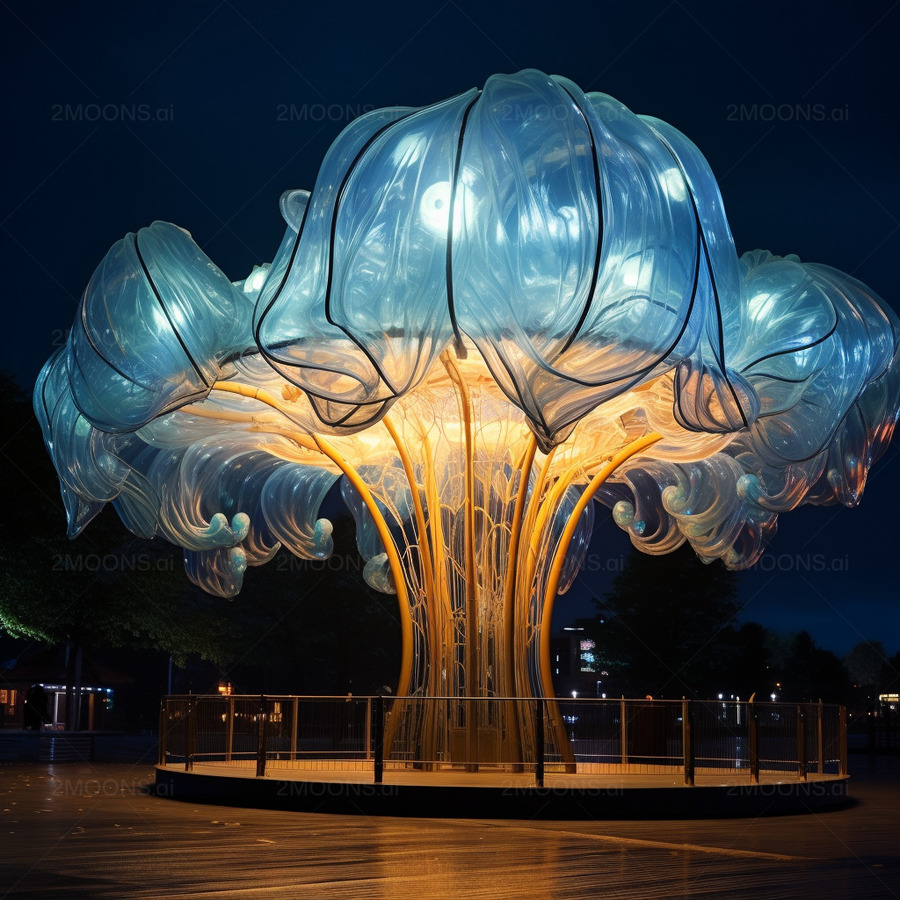
4. Environmental Signaling and Wayfinding: Bioluminescent architectural features can serve as environmental signaling and wayfinding elements, guiding occupants through architectural spaces and enhancing spatial orientation. By integrating bioluminescent pathways, signage, or markers into building designs, architects can create intuitive navigation systems that adapt to changing environmental conditions, such as darkness or low visibility. These bioluminescent wayfinding elements promote safety and accessibility in indoor and outdoor environments, improving user experience and satisfaction.
5. Sustainable Lighting Solutions: Bioluminescent architectural features contribute to sustainability by reducing reliance on conventional electric lighting systems and minimizing energy consumption and carbon footprint. Living organisms and synthetic bioluminescent materials offer renewable and biodegradable alternatives to traditional lighting technologies, promoting resource efficiency and environmental stewardship in architectural design. Additionally, bioluminescent lighting installations require minimal maintenance and operational costs, further enhancing their sustainability credentials and lifecycle performance.
Biotechnology in architecture offers architects a versatile toolkit for integrating bioluminescent architectural features into building designs, creating visually stunning and environmentally sustainable lighting installations. By harnessing the light-emitting properties of living organisms and synthetic materials, architects can transform architectural spaces into luminous and immersive environments that inspire wonder, promote well-being, and contribute to a more sustainable future. As biotechnological advancements continue to evolve, the potential for innovation in bioluminescent architecture is limitless, offering exciting opportunities for creative expression and ecological harmony in the built environment.
Suggested article to read: Reduce Carbon Emission in Construction; Ultimate Guide in 2024 | Decarbonizing Construction; A Sustainable Future Ahead (2024 Solution)
Conclusion
In recent years, the integration of biotechnology in architecture has sparked a revolution in sustainable and innovative building practices. Across various facets of architectural design, from materials and facades to living structures and lighting features, biotechnology has opened new avenues for creativity, sustainability, and resilience.
The use of biologically derived materials exemplifies this transformative shift, offering architects the opportunity to create structures that not only minimize environmental impact but also exhibit remarkable durability and performance. Through biotechnology, architects can harness the regenerative capabilities of living organisms to develop self-healing structures, ensuring longevity and reducing maintenance costs. Furthermore, the incorporation of living organisms into architectural designs not only enhances environmental sustainability but also promotes biodiversity, ecosystem services, and human well-being.
Biotechnology in architecture has also facilitated the development of adaptive facades, circadian lighting systems, and bioluminescent architectural features, which not only respond intelligently to environmental stimuli but also enhance occupant comfort, health, and productivity. By drawing inspiration from nature’s solutions to complex challenges, architects can create buildings that seamlessly integrate with their surroundings, optimize resource use, and foster a deeper connection with the natural world.
As biotechnological advancements continue to evolve, the potential for innovation in architecture is boundless. From self-healing structures that mimic biological processes to bioluminescent features that captivate the imagination, biotechnology offers architects a rich palette of tools and techniques to create buildings that are not only functional and beautiful but also sustainable, resilient, and transformative. In embracing biotechnology, architects have the opportunity to shape a future where the built environment harmonizes with nature, enriches human experiences, and contributes to a more sustainable and equitable world.
FAQs
What is Biotechnology in Architecture?
- Answer: Biotechnology in architecture involves employing living organisms and biological procedures to develop sustainable, adaptive, and creative building solutions.
How does Biotechnology Contribute to Sustainable Architecture?
- Answer: Biotechnology provides eco-friendly materials and structures, decreasing consumption of energy, waste, and the environmental effects of constructions.
What are some Examples of Biotechnology Applications in Architecture?
- Answer: Bioluminescent lighting systems, living walls, mycelium-based materials, and bioplastics are a few examples.
Resources:
Parametric Architecture | Urban Next | Science Direct | Archdaily | The Conversation | BioMed Central
For all the pictures: Freepik | developmentone | Livin Spaces | Floornature | Arquitectura | 2 Moons | TU Delft | The Green Cities Company

